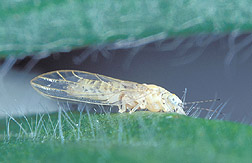This page has been archived and is being provided for reference purposes only. The page is no longer being updated, and therefore, links on the page may be invalid.
|
Read the magazine story to find out more. |
Insect Pair Stalls Everglades InvaderBy Alfredo FloresNovember 7, 2002 For years, melaleuca--a fast-growing invasive tree from Australia--has been taking over 14 to 15 acres a day of south Florida's Everglades, making it a significant threat to the stability of this fragile ecosystem. Now, to the rescue has come a gnat-sized psyllid, Boreioglycaspis melaleucae. This tiny insect is a natural enemy of melaleuca in its native country, and both adults and their offspring feed on the tree's clear sap. Their favorite sap is inside the tips of a melaleuca's newest stems and branches. Young melaleuca seedlings are the most vulnerable to the psyllids' attack, but the pests can also stunt the growth of bigger trees. Their feeding slows down melaleuca seed production by damaging tips that would otherwise form seed capsules. Some 100,000 psyllids have been released at a variety of south Florida sites, ranging from a cluster of melaleuca trees standing in water to an unusually dry pasture dotted with melaleuca stumps. The psyllids' presence in south Florida is the result of more than five years of research by Agricultural Research Service scientists at the Australian Biological Control Laboratory in Indooroopilly, Australia, near Brisbane; their colleagues with Australia's Commonwealth Scientific and Industrial Research Organization; and co-investigators at the ARS Invasive Plant Research Laboratory, headquartered in Fort Lauderdale, Fla., with a satellite location in Gainesville, Fla. Philip W. Tipping, an ARS entomologist at the Fort Lauderdale lab, and colleagues expect the psyllid to complement the efforts of another weed warrior from Australia--the melaleuca leaf weevil, Oxyops vitiosa. Its first release was made in 1997, with 1,600 weevils distributed at 11 melaleuca-infested sites in south Florida. Today, millions of the quarter-inch-long weevils are eating the silvery leaves of melaleuca saplings. Losing leaves stresses the trees and lowers seed production, which can otherwise reach 60 million seeds a year in mature trees. More about research on these two melaleuca-controlling insects can be found in the November issue of Agricultural Research. ARS is the U.S. Department of Agriculture's main scientific research agency. |

